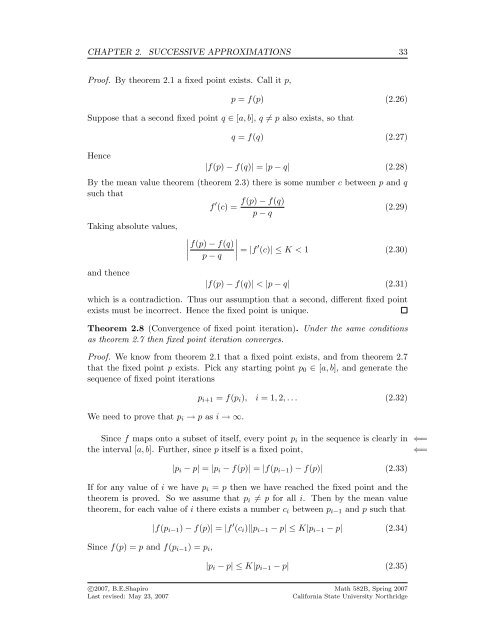The Computable Differential Equation Lecture ... - Bruce E. Shapiro
The Computable Differential Equation Lecture ... - Bruce E. Shapiro
The Computable Differential Equation Lecture ... - Bruce E. Shapiro
You also want an ePaper? Increase the reach of your titles
YUMPU automatically turns print PDFs into web optimized ePapers that Google loves.
CHAPTER 2. SUCCESSIVE APPROXIMATIONS 33<br />
Proof. By theorem 2.1 a fixed point exists. Call it p,<br />
p = f(p) (2.26)<br />
Suppose that a second fixed point q ∈ [a, b], q ≠ p also exists, so that<br />
Hence<br />
q = f(q) (2.27)<br />
|f(p) − f(q)| = |p − q| (2.28)<br />
By the mean value theorem (theorem 2.3) there is some number c between p and q<br />
such that<br />
f ′ f(p) − f(q)<br />
(c) = (2.29)<br />
p − q<br />
Taking absolute values,<br />
and thence<br />
f(p) − f(q)<br />
∣ p − q ∣ = |f ′ (c)| ≤ K < 1 (2.30)<br />
|f(p) − f(q)| < |p − q| (2.31)<br />
which is a contradiction. Thus our assumption that a second, different fixed point<br />
exists must be incorrect. Hence the fixed point is unique.<br />
<strong>The</strong>orem 2.8 (Convergence of fixed point iteration). Under the same conditions<br />
as theorem 2.7 then fixed point iteration converges.<br />
Proof. We know from theorem 2.1 that a fixed point exists, and from theorem 2.7<br />
that the fixed point p exists. Pick any starting point p 0 ∈ [a, b], and generate the<br />
sequence of fixed point iterations<br />
We need to prove that p i → p as i → ∞.<br />
p i+1 = f(p i ), i = 1, 2, . . . (2.32)<br />
Since f maps onto a subset of itself, every point p i in the sequence is clearly in ⇐=<br />
the interval [a, b]. Further, since p itself is a fixed point, ⇐=<br />
|p i − p| = |p i − f(p)| = |f(p i−1 ) − f(p)| (2.33)<br />
If for any value of i we have p i = p then we have reached the fixed point and the<br />
theorem is proved. So we assume that p i ≠ p for all i. <strong>The</strong>n by the mean value<br />
theorem, for each value of i there exists a number c i between p i−1 and p such that<br />
Since f(p) = p and f(p i−1 ) = p i ,<br />
|f(p i−1 ) − f(p)| = |f ′ (c i )||p i−1 − p| ≤ K|p i−1 − p| (2.34)<br />
|p i − p| ≤ K|p i−1 − p| (2.35)<br />
c○2007, B.E.<strong>Shapiro</strong><br />
Last revised: May 23, 2007<br />
Math 582B, Spring 2007<br />
California State University Northridge
















